Getting Started with Softened Water
The first few days
Your water softener will start softening the water as soon as it is installed and commissioned.
Taps connected directly to the softened water supply will give lovely softened water immediately. It will take a few days or longer (depending on the size of your loft tank) for the newly refined water to fill your storage tank in the loft (if you have one) and work its way through your hot water system.
You should, however, have partially softened hot water in one to three days and fully softened hot water throughout your house within three to seven days.
If you have a direct mains-fed water system, such as a combination boiler, softened water will be ‘on tap’ everywhere within a matter of hours.
Salt consumption may be higher initially as the initial brine solution is created, but this will reduce within the first week as the brine mix settles down in the cabinet.
The correct description - Silky, Slimy or Smooth?
There are many descriptions given to softened water. The correct one is silky. If the water is correctly softened, there will be no chalk in the water and therefore the silky feeling are your natural body oils not being blocked by chalk.
If the water is too silky, try using less soap. The silky feeling is what protects your skin from dry skin conditions and helps with acne control too, as there is then no chalk in the water which will block the pores of your skin.
Opening the bypass:
You could open the bypass slightly to let in some hard water. However, be advised that this will then once again leave watermarks on taps and shower screens (we call this cosmetic staining), and create a buildup of soap scum.
It can also cause scaling in the kettle and leave scum on your tea. It can also then further impact dry skin conditions as just the smallest amount of chalk in the water.
My Advice?
Adapt to softened water by experimenting with using less soap, or changing to a different soap / detergent. You'll be delighted with softened water once you get familiar with what true water should really feel like.
Softened water in the bathroom

Liquid Soaps vs Bars of Soap
Using liquid soap in the shower is a common practice nowadays, especially for those with hard water. However, liquid soaps may not provide a noticeably different experience if you have softened water. This is because most liquid soaps and detergents are designed for hard water, which can result in an oily film when used with softened water.
To enhance your shower experience and be kinder to your skin, consider using traditional soap bars like Dove, Simple, or the lovely larger bars found in stores like TK Maxx (my dad loves these!). Soap bars typically create a very rich lather and leave your skin feeling silky, giving you a refreshing spa-like feeling after your shower.
Bubble Bath
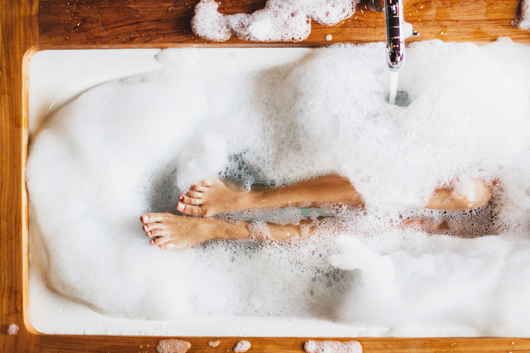
Rather than using expensive bubble baths (again, they are formulated with extra softening chemicals so that they work well in hard water), in softened water the bubbles can quickly dissipate. instead, try holding a bar of soap under running warm water to create a tub full of bubbles. This is a cost-effective way to enjoy a luxurious bubble bath experience. If I want that even silkier feeling, I sometimes tend to leave the bar of soap in the bath while I'm in it!
Hand Soaps at the Sink
If you prefer liquid soap at the sink, experiment with different types until you find one that suits you best.
Shaving with Softened Water

Shaving with softened water is a delightful experience and can prolong the life of your razor blades. You don't even need to use shaving foam; a bar of soap can create a luxurious foam that leaves your skin feeling fantastic. If you currently use an electric razor, you may be missing out on the benefits of a close and comfortable shave.
That Slippery Feeling
It's important to note that the bath and shower surfaces may feel slippery when using softened water. Unlike hard water, softened water doesn't leave soap scum, which can create a barrier and cosmetic staining. Therefore, surfaces may appear more slippery. Similarly, if your skin feels slippery (never slimy), it means you're using too much soap. Simply reduce the amount you're using. When the chalk is removed from the water, our pores don't tend to clog, which allows our natural body oils to moisturise the skin. This is why softened water is often very beneficial for those with eczema and other dry-skin conditions.
Softened Water makes Cleaning Easier
Another advantage of using softened water is that it doesn't leave any residue, making cleaning the bath or shower easier. The water easily slips away down the drain, so all you need to do is rinse once done.
Softened water in the laundry

Liquid Detergent vs Powder Detergent
One of the remarkable benefits of softened water is its significant reduction in soap consumption, and this is particularly noticeable when using a washing machine.
When using liquid detergents, you can typically cut the amount needed in half. For example, you can reduce the quantity from about 35ml to 15ml, resulting in savings of over 50%. Similarly, powder detergents can be reduced from around 125ml to an incredibly low 25ml, which is a substantial saving!
We recommend experimenting with different amounts until you are satisfied with the results. In my own home, even with two teenagers who tend to get quite dirty, we haven't noticed any difference in washing performance by using less detergent.
Several customers have shared with us that they have switched from heavy-weight powders like Persil to lightweight powders such as Fairy. This is because some of the ingredients in heavy-weight powders, specifically designed to combat water hardness, are not as effective in softened water.
Fabric Conditioner
You may also find that you don't need to use fabric conditioner. Try washing without it and see if there is any noticeable difference in the softness of your clothes. Alternatively, you can use half the recommended amount. It's worth noting that using a fabric conditioner can help reduce static cling when ironing.
The Tumble Drier
One last thing to consider…. The best way to get those hotel-soft towels is to dry them on a line, and then pop them in the tumble drier for ten minutes before putting them away!
Ironing with softened water
Many people say you should not use softened water in irons - this is because of the perception of corrosion.
My mum is the Queen of Ironing, it is something that gives her calm, and everything in her home is always neatly pressed. In my folks home, and in my own, we use softened water and neither of our irons have failed due to corrosion, but if we still used hard water, we would get scaling in the iron very quickly. Over the years, I have suggested to hundreds of customers to give it a go and see how they get on, and I have never heard anything negative.
So, I would suggest you give it a go, and see how you get on. I suspect you will find it perfectly fine for your needs.
Softened Water in the Kitchen

The Kitchen Sink
When washing dishes at the kitchen sink, you can now use only half the amount of washing up liquid you used to use. It's important to understand that bubbles don't actually wash dishes, it's the soap that does the cleaning. So, don't be alarmed if you notice fewer bubbles when using softened water.
The reason, however, for fewer bubbles is that dishwashing liquids are typically formulated for hard water. This doesn't affect the cleaning power of the detergent. In fact, you'll find that sinks remain cleaner and the entire washing process becomes easier to handle. Most items, including glassware, will dry on the drainer without any marks or stains.
It's worth noting that cheap detergents may not work well in softened water and can leave an unpleasant greasy film. It's recommended to stick with a higher quality detergent like Fairy to ensure optimal results.
The Dishwasher
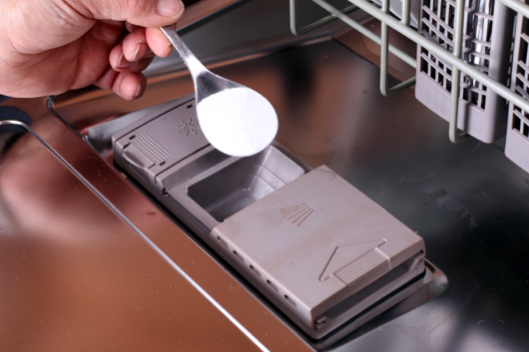
You can significantly reduce the amount of dishwashing liquid or powder used in the dishwasher and achieve a better quality wash.
Instead of using dishwasher tablets, you can instead use dishwasher powder, which only requires a teaspoon for each wash. This means that a bottle of dishwasher powder, costing around £4, can last you an entire year, compared to a box of tablets that lasts typically only a month and costs approximately £7.
It is important to note that you no longer need to add salt to the dishwasher. Adding salt can actually be detrimental as it can increase the sodium level in the machine excessively, especially since the water is already softened. The combination of the alkalinity of the cleaning agent and the additional salt can make the water very aggressive, potentially causing etching problems on delicate crockery and glassware. It is recommended to wash delicate items by hand.
With regard to Rinse Aid, it is a good idea to keep using this. Rinse Aid helps water glide off your dishes and glasses, so they dry more quickly and stay streak-free. By reducing the surface tension of the water, it stops droplets clinging to surfaces — meaning fewer water marks and a much clearer finish. In hard water areas where a water softener is not installed, it plays an additional role where it is especially useful for preventing spotting and keeping everything sparkling.
Softened Water with Tea and Coffee
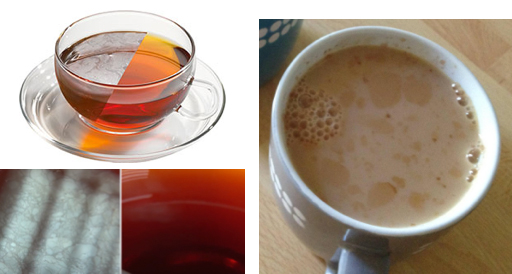
While some people may choose not to use softened water for drinking purposes, many owners of water softeners actually prefer it over hard water. This is because hard water, which contains chalk, can mask the flavour of tea and coffee and leave an unsightly scum on cups of tea.
On the other hand, softened water has the ability to enhance the taste of tea and coffee, making them much more enjoyable. Additionally, when using softened water, less tea and coffee is needed to achieve the same strength of ‘brew’.
Softened water can also improve the taste of other beverages, such as cordials and hot chocolate.
An interesting anecdote that showcases the benefits of softened water involves my mother and a cup of tea I made for her a few years ago.
When I told my mum that I was planning to leave British Gas, she expressed concern that the water softening industry was Mickey Mouse when she noticed the stark difference in tea quality between my home and my grandparent's home in the Cotswolds. At my grandparent's home, the tea always had a film floating on top and sticking to the mug, while there was none at my home. This impressed mum so much that when my parents retired back to the UK, one of the first purchases they made for their new home was a water softener.
Softened Water will Descale Kettles - and Protect your Boiling Water Tap too!
If you make tea and coffee with softened water, you will find the kettle will descale itself in a couple of weeks. After all the scale has dissolved away, the inside base of the kettle may turn brown or black over a period of time. This is quite normal and is not detrimental in any way.
If you have a boiling water tap such as a Quooker, then you definitely will want to run that on softened water. The manufacturer in fact recommends it, but be sure to choose the right softener! Cheaper softeners can be problematic where boiling water taps are concerned! My Quooker is now 7 years old, and has never been serviced, thanks to our softener protecting it!
Softened Water in the Garden

Watering the Garden and indoor plants
Contrary to popular belief, using softened water for watering plants is actually generally fine. Softened water does not contain salt, but instead has traces of sodium at very low levels. Sodium is a natural mineral that promotes plant growth.
Most plant species can tolerate softened water without any issues. However, there have been a few cases where certain plants were less tolerant. In such situations, it is recommended to bypass the water softener and use unsoftened water specifically for those plants.
The RHS (Royal Horticultural Society) advises against using softened water due to the increased sodium content. However, in reality, the sodium in softened water dissolves when it rains and does not stay in the soil. While it is present, it acts as a growth mineral, benefiting the plants.
The only time when a buildup of sodium is more likely to occur is during a drought. If you regularly water your garden with softened water during very dry months, there is a possibility of excess sodium buildup in the soil. In such cases, it is advisable to bypass the water softener every few waterings if your outside taps are softened.
During the regeneration process of a water softener, only a small amount of brine water is used to remove captured chalk. Afterwards, the cylinder is flushed with fresh water to eliminate the salty water, making it safe for drinking purposes. For instance, the Harvey softener uses just 1 litre of brine water (equivalent to 300g of salt) and is followed by 16.1 litres of fresh water.
Considering this, using softened water for your garden will not significantly increase your salt consumption either. In the video testimonial below, our customer Joan mentions that she uses approximately 1/3 of a block more salt per month when watering her substantial garden with softened water, resulting in an additional cost of around £3 per month. Nevertheless, she has experienced fantastic results in her garden.
In 2022, more than 70% of customers with water softeners installed have chosen to use softened water in their gardens.
Softened Water and the Aquarium

Most tropical and marine fish require special water conditions and softened water may not be satisfactory. It is advisable to seek the advice of your local aquaria stockist.
If you don't have a hard water tap, then please remember to bypass your water softener when topping up the fish tank/pond, unless you have a reverse osmosis system fitted, in which case the water softener will protect the RO system membrane from calcium damage, and will in turn remove any excess sodium from the water supply.
Softened Water and Car Washing / Window Cleaning

Car washing and window cleaning can be a chore.
Softened water makes it easier. Less drying marks are created and finishing a car off with a leather chamois is not essential.
Professional car enthusiasts, car washing firms and window cleaning businesses would ideally then run the softened water through a reverse osmosis system to get the water down to 98% purity, and finally polish the water through a DI resin to take it to 99.9% purity. This would then leave the glass and bodywork spotlessly clean. Such purity also breaks the static on the glass and body of the vehicle, leaving a cleaner finish for longer.
This is a sector we have a significant amount of knowledge in, having previously run the window Cleaning
The Descaling Action of Softened Water
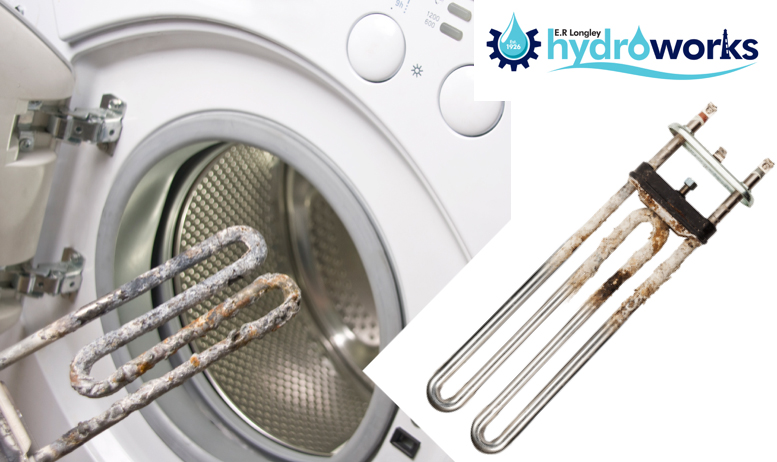
Softened water will completely descale pipes, hot water cylinders and appliances. The electric kettle will take about six weeks to become clean. Your water system will take longer, depending on the build-up of scale. A really bad situation could take several years before it becomes clear of scale, but this is rare.
As scale is porous the cleaning action of softened water will not in any way cause leaks in a water system. The removal process is actually quite gentle. Water quality meanwhile is not impaired.
Where scaling is particularly bad a definite improvement in heating efficiency will be noted in time.
Appliances, such as dishwashers and washing machines, will also operate more effectively and typically last considerably longer.
The action of softened water on scaled fixtures and fittings
Initially, unsightly scale can be removed by soaking overnight with a rag soaked in vinegar or by using a propriety cleaner. More than one attempt may be necessary. Care must be taken with plastics and acrylic.
It may be best to leave softened water to act on the stains to naturally remove them. This will take time but often less damage results. This is particularly true of gold plated fittings.
Even the most stubborn scale will eventually dissolve away, and it has been known to see the luster returning to sinks and baths within just a few months.
In your showers, it would be best to ensure that you rinse everything, including the tiles whilst in the shower, and if you leave it all wet, it will help speed up the descaling process (but not if you have coated fittings - see the section about coated fittings in Softened Water in the Bathroom, above)
Testing to see whether the water is soft
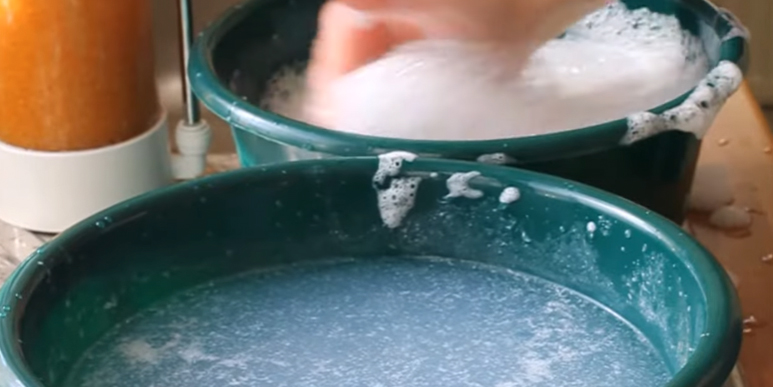
If you are unsure that the water is soft it is very easy to check.
Take two identical bowls and fill one from the outside tap (if it’s on hard water) and one from a tap which should be giving softened water.
Use an ordinary bar of soap (such as Simple soap) and rub in the bowl of hard water. You should immediately see the water going cloudy and within a short time a scum form. Eventually, the water will prevent you from seeing your hand resting on the bottom of the bowl.
Remove the soap and repeat the exercise in the second bowl (soft water) and repeat the exercise.
You should obtain an immediate lather with little effort. There should be no residue whatsoever and the water should remain almost totally clear. If there is any sign of cloudiness, or a film begins to form (curd), then the water is not soft and it may be necessary to seek our advice.
If you’d like to see a demonstration of softened water vs. Hard water, you can watch my colleague Chris Larkin do an excellent one below:
Obtaining salt for your water softener

You may think all salt is the same. Unfortunately, it is not, and there are significant differences in type and quality.
There are tablets, granular and block salts (oblong or curved)
In those types, there is sea salt or lake salt (never recommended and unfortunately widely available and often falsely labelled as suitable for water softeners), and Grade A (Pure Salt). This is such a problem for softener owners as the wrong salt will damage your softener and invalidate your guarantee. I have written a page about this: Which salt is best for my water softener.
Make sure you buy the salt designed to work in your machine and beware of salt in unfamiliar packs at cheap prices.
We offer a free local salt delivery service and our pricing is highly competitive, plus you will always be guaranteed that it will be the right type and quality. You can see our salt pricing and order your salt from our online shop, or if you prefer, over the phone at 01795 342 182.
Caring for your water softener
Most water softeners are robust appliances and should give many years of satisfactory service.
Your softener's cabinet may need a clean from time to time. All that is required is a wipe-over with a damp cloth.
If there is a malfunction, please do not attempt to look into the workings of the machine, unless you are technically au fait with softeners. They are more complex than they look and you may do more harm than good.
Always telephone us if you have a query.
Water softener model type will determine when a service is required. In a domestic environment, we would typically say annual servicing is not necessary and would recommend every 3 years, but be careful. Some manufacturers say that if the product is not serviced annually, it will invalidate the warranty. We can always guide you.
Salt Creep
From time to time, customers may notice white salt crystals forming within the inside and on the outside of the softener cabinet.
The problem can be exacerbated in homes where air movement in and around the softener is stagnant and generally warmer. Cupboards close to heating boilers are particularly vulnerable.
The problem arose through a change in the packaging of the block salt. During 2007, wrapping the blocks in shrink film before applying the outer wrapper was introduced as a more convenient packaging process. Previous to this the blocks were manufactured and packed within a cardboard sleeving. The sudden appearance of ‘salt creep’ alarmed many customers thinking their softeners were malfunctioning. This is not the case.
It was found that the shrink-wrapping traps excess moisture within the salt blocks. On exposure to air, within the softener, the blocks sweat, and in a warmer atmosphere the evaporated salt immediately crystallises on adjacent cooler surfaces. Nowadays, salt manufacturers don’t use cardboard sleeving as the cardboard can stick to the salt blocks and that is highly then likely to block the brine valve system. As a result, salt creep is increasingly common.
Although inconvenient, this unsightly phenomenon can be removed from the cabinet with a cloth soaked in warm water.
In locations where the atmosphere is particularly dank, stagnant, and warm, we recommend increasing the airflow in and around the softener. At night time, when you go to bed, open the kitchen or utility cupboard to get air flowing around the softener.
IMPORTANT NOTE about electronic water softeners with time clocks
If you have a time clock controlled water softener we strongly advise you to turn it off if you are away, from home, for any length of time. If not it will regenerate even when water is not being used and use excess amounts of salt. The water could become very salty. The softener timer will need to reset when you get back.
- - - - - -
Why do some people get watermarks after a softener is installed?
There are two answers to this question:
Hard Water Coatings
Firstly, but seldomly, your sanitary ware may have a hard water coating. A hard water coating helps protect sanitary ware from the effects of limescale, but when a water softener is fitted, it can have the reverse effect and cause watermarks.
We come across hard water coatings very infrequently, but they are out there. Where we do, it might be just one or two fittings in the home (normally high-end fittings), so if you are planning on refurbishing your bathroom, be sure to choose fittings which are not coated!
If you find you are getting watermarks, check to see if your fittings have a hard water coating. If they do, it would be a good idea to wipe down as you finish bathing/washing.
The reason watermarks (cosmetic staining) occurs is that when softened water goes on to a coating, depending on what coating is applied to the fitting, the coating might repels the water and create a reaction which causes the watermark.
Grohe fittings (from Grahams merchants) are generally coated, whilst Iflo and Bristan from other merchants like City Plumbing are mostly not. But do your research, there are many brands that are not coated!
Other minerals in the water supply
A water softener only removes calcium and magnesium, and a variety of other normally non-marking minerals are left behind.
In almost all cases, remaining minerals (including copper, chromium, lead, arsenic, fluoride, radium, sulfate, potassium, nitrate, phosphorous and more) can, but rarely, leave watermarks in homes. However, we must be mindful that they are still in the water supply. This is why window cleaners use typically three processes of water treatment to get their water 99.9% pure. They start with a water softener, then the filter through a reverse osmosis system, and lastly they polish the water through a DI Resin system. Without either of those steps*, they would leave watermarks on customer's glass.
It's not right or practical to do this type of treatment in the home, but it does help us to understand why sometimes even when no coating is on a fitting or glass, we can still get some watermarks.





